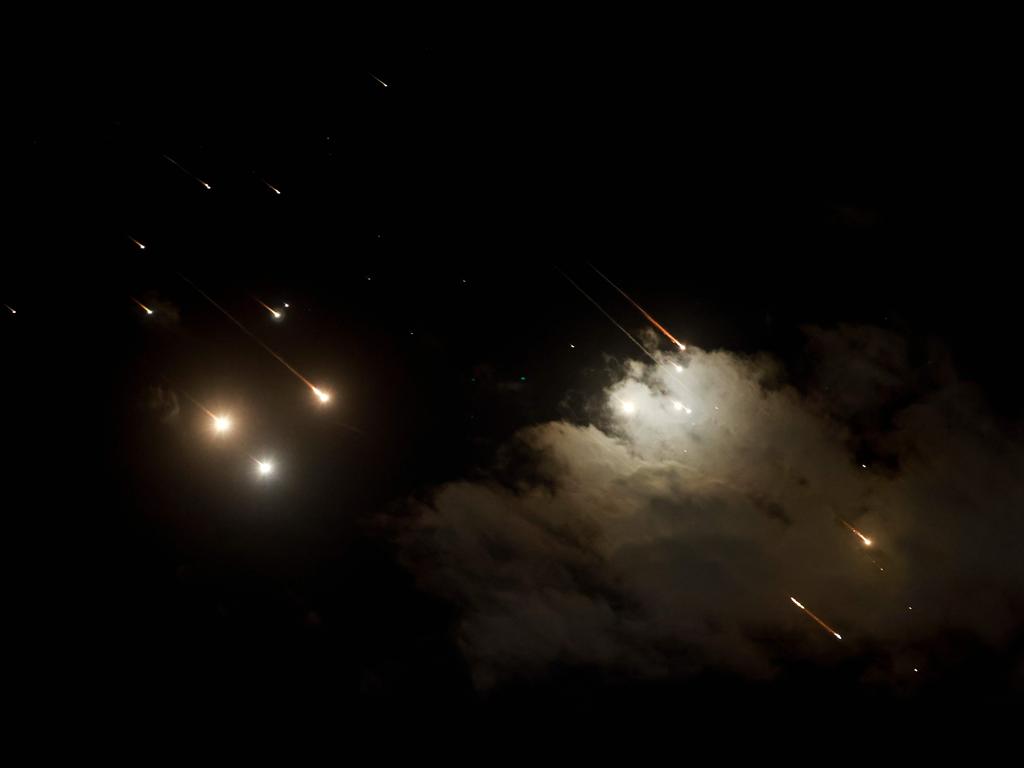
Being able to see well is useful in news gathering. However, when The Australian hired me in 2004, the higher-ups were unbothered that my vision is so low I’m not permitted to drive a car.
I once found a death squad commander when Interpol couldn’t. But I will not cross a street unless I see and hear the green man.
An endless challenge for news editors is that good reporters are good at different things.
But being there is the only thing that matters on a story as big as this. So when the bombing started in Israel last week, and I was already there on a tour, I became an accidental war correspondent until reinforcements arrived. I was ahead of the big TV networks of the world, reporting from a hotel balcony in Jerusalem and from inside a bomb shelter. I took it seriously.
I expect few Middle East reporters will message a test video home to their spouse before recording the real thing. (Question: Does this look OK? Answer: It’s straight but clean the lens.)
Needs must.

I had arrived in Tel Aviv on June 8 to follow Olympian Nova Peris and a delegation of Indigenous Australians on a tour hosted by the Australia/Israel & Jewish Affairs Council. I am the newspaper’s Indigenous affairs correspondent. It is a sad fact that racists enjoy flooding the social media accounts of high-profile Indigenous Australians just because they can. Peris is now targeted with extra venom for her stance on Israel.
The hate went into another gear in 2024 when Peris started pushing back on the pro-Palestinian movement’s central claim that Jews were the colonisers in Israel. The pro-Palestinian movement in Australia has worked hard to align itself with the Aboriginal rights movement, even creating a brooch with the Palestinian and Aboriginal flags side-by-side.

Peris wanted other First Nations Australians to see for themselves that Jews were Indigenous to Israel and 4000 years of archaeology shows this.
I watched the delegates walk through the ancient City of David. It was especially moving to see Kimberley leader Ian Trust at the places his deeply Christian parents spoke about so often when he was growing up.
Trust stood on Pilgrimage Road, the 2000-year-old stepped stone path where historians believe Jesus and his disciples walked daily, and he went quiet.
“My parents would have loved to have seen this,” he said.

My most difficult experience in Israel was not the bombings, it was a 47-minute video of the October 7, 2023 attacks. I’m told Anthony Albanese has not seen it.
In the video, the gunmen seem high. There is no narrator. The sounds and images are compiled mostly from iPhones, CCTV and Hamas body-worn cameras.
One of the killers is recorded calling home to boast to his father that he has killed 10 Jews.
“I killed them with my bare hands,” he says. “Your son’s a hero.”
One gunman kicks a corpse and asks his fellow gunmen: “Is it dead?” He shoots the deceased in the head just in case.
I regret to say the beheading in this video is not the most chilling act captured. The footage that will most haunt whoever sees it is in CCTV from a home at a kibbutz in Israel’s south. First a young Hamas gunman arrives and his body-worn camera records his heavy breathing. A chonky labrador approaches, tail wagging, and he shoots it. It is still standing after the first shot and he shoots it twice more. The dog hits the ground and doesn’t move after that.
Meanwhile, CCTV from the family home shows the dad has seen or heard what’s going on because he is carrying one of his sons and ushering the other through a courtyard and into what looks like a laundry room or a shed. He is in front of the boys, protecting them, when the gunman throws a grenade and kills him.
The little boys rush to a couch where the CCTV shows the backs of their heads as they cry. The gunman rummages inside a nearby fridge for a cool drink. The older boy tells his little brother: “I think we are going to die.”

That day Hamas slaughtered 1200 people. The terrorists murdered Jews, Arabs and foreign nationals including a migrant worker from Thailand.
It occurs to me I have struggled to understand this because I’m Australian. We couldn’t know what it’s like to live surrounded by neighbours with the stated aim of wiping us off the face of the Earth.
Israel had attacked Iran’s nuclear weapons when I went to sleep on Thursday, June 12, fully dressed, including in socks and sneakers for speediest arrival at the bomb shelter near my hotel room. Iran’s first retaliation came in the early hours of Saturday, June 14.
A full-scale alarm was blaring as I scanned the faces of two men and one other woman in the bomb shelter on the seventh floor of the Cassia Hotel, Jerusalem.
A third man arrived and stood diagonally across from me in this 3m x 4m bunker. He moved around a little, stepping and turning as he told us that he looked outside in the moments between the “get ready” alarm and the “go now to the bomb shelter” alarm.
He saw the night sky had turned from black to orange. He was tense as he told us that he filmed lights moving above the city. He showed us the video he made of this on his phone.
“What the f..k did I see,” he said.
None of us knew.
“I am shaking,” he said.
Then we heard loud bangs. They sounded like bombs going off in the distance.
I did not know it then, but what we were listening to were the sounds of Israel intercepting and blowing up Iran’s ballistic missiles.

I turned my phone camera on to myself and filed a video report from the bomb shelter. The Australian’s video editor, Bianca Farmakis, sent me a text: “Hello! Just got your vid, do you know who that is in it speaking?”
I replied: “It’s me with no makeup hahaha.”
Bianca likely knew me from my very polished work photo published online. I didn’t resemble it that night.
I read the exchange with Bianca to the others in the bunker and we all roared with laughter, bedheads nodding.
For the next 32 hours I used my iPhone, a collapsible tripod and a cord with lapel microphone to make video reports for The Australian. This very basic kit fit in an old school pencil case.

I told myself things were OK because Jerusalem had not been attacked – maybe it was not a target – and because we were in a building that could take a direct hit. Then, in the early hours of Sunday, June 15, a ballistic missile hit a 32-storey apartment building in Tel Aviv. The entire facade was sheared off and people died.
Hi everyone,
— Nova Peris OAM OLY (@NovaPeris) June 13, 2025
It’s after 2 a.m here in Israel. I’m with 11 other Australians, including several First Nations brothers and sisters. The past 24 hours have been deeply confronting. We spent the early hours of yesterday in a bomb shelter, and much of today there too.
The last four… pic.twitter.com/LTx63KIpnv
That building did not look as solid as the hotel where I was staying but one of the two things I had been telling myself – that buildings were missile proof – now was clearly not true.
My colleagues Yoni Bashan and Liam Mendes were on their way to Israel, having figured out a route by road. I was in awe of them. I couldn’t wait to leave.

I said yes immediately to the Australia/Israel & Jewish Affairs Council’s plan to go to Jordan in a bus. We would be joined by five young Australians who wanted to get home. Most had been working in Israel on their gap year.
On my final night in Jerusalem, Bashan and Mendes reached Tel Aviv and started working right away. They went to the apartment building that had been hit by an Iranian missile.
They took shelter in a stairwell when the first siren went off.
I made a list of the people I’d met during the previous week and sent their names, numbers and a short biography to Bashan and Mendes. I wished them both well and felt instantly anxious for them.
That last night in Jerusalem I went to the bomb shelter and sat with Trust. We didn’t talk about the bombs. I told him I was making my porch into a sunroom. It was kind of thrilling to find someone I had not told. He told me his grandson was staying at his place while he was away. Grandson said he didn’t smoke. CCTV direct to Trust’s phone said otherwise. The kid was throwing the butts on the garden. Trust smiled and showed me on the phone. I hope that young man had his story straight when the confrontation came.
I cleared the final checkpoint into Jordan shortly before noon on Monday. In Amman, I brought a pomegranate juice, swam in the hotel pool and smiled with relief. Only 160km away, over the border, people were preparing for another hellish night.
Paige Taylor travelled to Israel as a guest of the Australia/Israel & Jewish Affairs Council to report on a delegation of Indigenous Australians led by Nova Peris.






